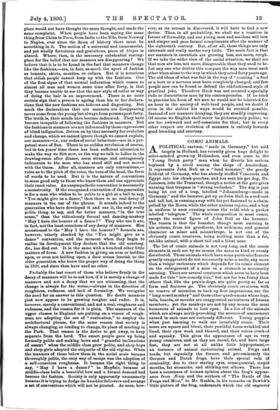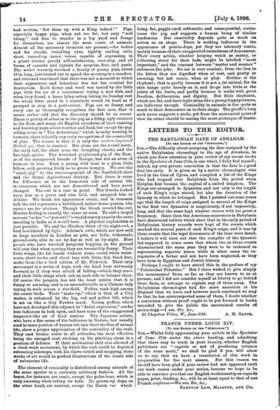COMIC ANIMALS.
APOLITICAL cartoon, "made in Germany," but sold largely in Holland, has recently given huge delight to sober-minded grown-up Hollanders, and even more to the "Young Dutch party" man when he diverts his serious boyhood by a stroll among the shops of Amsterdam. It represents John Bull as a "land hamster," the greedy field-rat of Germany, who has already stuffed Venezuela and Egypt into his cheek-pouches, and has sent his pet dog, Dr. Jameson, into the Transvaal, though a notice at the gate gives warning that trespass is " streng verboden." The dog is just being let out of a trap, labelled " Johannsburg—made in Germany," and the hamster, got up as John Bull in a red coat and tall hat, is running away with his pet fastened to a chain, pelted by the Boers, while the other nations rejoice, and a boy in uniform is seen running across the veldt with a packet labelled "telegram." The whole composition is most comic, except the central figure of John Bull as the hamster. The reason is that the hamster, though most amusing in his actions, from his greediness, his sulkiness, and general character as miser and misanthrope, is not one of the obviously comic creatures, being nothing more than a fat, rat-like animal, with a short tail and a blunt nose.
The list of comic animals is not very long, and the comic elements in each are by no means the same in kind or evenly distributed. Those animals which have some particular feature greatly exaggerated do not necessarily raise a smile, any more than a vulgar caricature which depends for its comic element on the enlargement of a nose or a stomach is necessarily amusing. There are several creatures which seem to have been made for this "low-comedy line," bat are far less funny than others that, like the prairie-dogs, are quite pretty so far as form and features go. The obviously comic creatures, with no reserve of intention to back up first impressions, are the "long-nosed monkey" and those other quadrumana whose legs, tails, beards, or mouths are exaggerated caricatures of human members ; yet the monkeys are not by any means the most humorous of animals to look upon. In a list of the animals which are always mirth-provoking the sources of amusement caused in each case are curiously different. Young puppies when just learning to walk are invariably comic. Their noses are square and blunt, their youthful faces wrinkled and lined, their eyes weak and bleared, and their voices cracked and squeaky. This gives the appearance of age in very young creatures, and as they are round, fat, and have large feet, they are not at all unlike little hippopotami,— an instance of animal caricaturing animaL Frogs and toads, but especially the former, and pre-eminently the German and Dutch frogs, have their special vein of comicality, due to their staring eyes, consequential, stupid months, fat stomachs, and sticking-out elbows. There has been a consensus of human opinion about the frog's appear- ance from .2Esop and the authors of "The Battle of the Frogs and Mice," to Mr. Ruskin, in his remarks on Bewick's little picture of the frog, underneath which the old engraver
had written, Set them up with a King indeed !" Pigs, especially happy pigs, when not too fat, but only "well liking," and free to wander in a big yard and forage for themselves, are almost the most comic of animals. Almost all the necessary elements are present,—fat bodies and fat cheeks, twinkling eyes, tightly curling tails, short, turned-up noses, voices capable of expressing in a grunt intense greedy self-satisfaction, curiosity, and all forms of squeaks and squeals for surprise, fear, and panic. The writer recently watched a family of young pigs, about 18 in. long, just turned out to spend the morning in a meadow, and returned convinced that there was not a moment at which their appearance and behaviour was not too comical for description. Each flower and weed was tasted by the little pigs with the air of a connoisseur trying a new dish, and when they found a horse lying asleep taking its Sunday rest the whole litter stood in a semicircle round its head as if grouped to sing in a pantomime. Pigs are so fanny, and every one so thoroughly recognises the fact now, that it seems rather odd that the discovery should be so recent. There is plenty of allusion to the pig as a filthy, ugly creature in the East, and many old English anecdotes of their cunning and knowing ways about weather and food, bat except the pig- selling scene in "The Acharnians," which is sadly wanting in humour, there is hardly any early recognition of the comicality of pigs. The rcason is that it is only the modern improved British pij that is comical. His alone are the round stern, the curly tail, the short nose, the dumpling cheeks, and the fine high spirits. The wretched greyhound-pig of the East, or of the unimproved breeds of Europe, has not an atom of humour in him. Even a young wild boar is a glum little fellow, only growing lively as he grows hungry. We owe the "comic pig" to the encouragement of the Smithfield show Enid the Royal Agricultural Society. But there is room for difference as to the humorous side of animal life in creatures which are not domesticated and have never changed. The owl is a case in point. The Greeks looked upon him as a grave and wise bird, and assigned him to Athene. We think his appearance comic, and in common talk the owl represents a bewildered, rather dense person, who cannot see the obvious. Though the Greek revered the owl, Hindoo feeling is exactly the same as ours. To call a stupid servant " ooloo "—"you owl !"—would convey exactly the same meaning in India as it would here. A physical explanation is just possible. We and the Hindoos think of the night-owl, a bird bewildered by light. Athene's owls, which are now sold in large numbers in London as pets, are little, wideawake ground-owls, able to see by day as well as by night. Most people who have watched penguins hopping on the ground will own that when moving they are irresistibly funny. Their little wings, like fat hands without arms, round white waist- coats, short necks, and short legs with little, flat, black feet, make them like a bird edition of Mr. Pickwick. Their only movement is a series of hops, with the head bent nervously forward as if they were afraid of falling—which they are— and their little wings stuck out on each side to balance them. Of course the penguin has not the least notion that it is funny or amusing, and is as uncomfortable as a Chinese lady trying to walk across a rice-field. Puffins rank high among the comic birds. Their "make-up," which is that of a City waiter, is enhanced by the big, red and yellow bill, which is set on like a Guy Fawkes mask. Young puffins, which have not developed this adjunct to "facial expression," are far leas ludicrous to look upon, and have none of the exaggerated inspector-like air of their seniors. The Japanese artists, who have a fine sense of the ludicrous in Nature, but usually read in some portion of human wit into their studies of animal life, show a proper appreciation of the comicality of the crab. They cast bronze crabs in all attitudes, the most effective being the enraged crab sticking up his pinching claws in a position of defence. If their mechanical skill also allowed of a clock-work movement, by which the crab could be depicted retreating sideways, with his claws raised and snapping, these works of art would be perfect illustrations of the comic side of submarine life.
The element of comicality is distributed among animals of the same species in a curiously arbitrary fashion. All the bears, for instance, are comic, except the polar-bear, which is only amusing when taking its bath. No grown-up dogs, on the other hand, are comical, except the Dutch ',Nu,- which
being fat, goggle-eyed, asthmatic, and consequential, carica- tures the pig, and suggests a human being of similar tendencies. But comicality depends quite as much on action as on shape. There is nothing ludicrous in the appearance of prairie-dogs, yet they are intensely comic, mainly because of their exaggerated earnestness of demeanour. Their every action, whether keeping watch as sentry, or collecting straw for their beds, might be labelled "most important," and the contrast between "matter and manner" enhances the joke. No cat is ever comical ; from the lion to the kitten they are dignified when at rest, and pretty or amusing, but not comic, when at play. Neither is the elephant ; that is partly because it is not a fat animal, for its skinhangs quite loosely on it, and drops into folds at the joints of the limbs, and partly because it walks with great freedom, deliberation, and dignity. But little elephants, which are fat, and have tight skins like a young hippopotamus, are ludicrous enough. Comicality in animals is due quite as much to their demeanour as to their shape. The giraffe's long neck never suggests a smile, yet from the anatomical point of view its owner should be among the most grotesque of beasts..











































 Previous page
Previous page